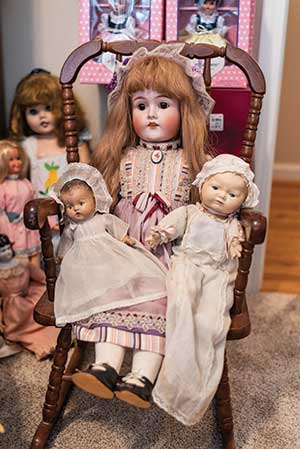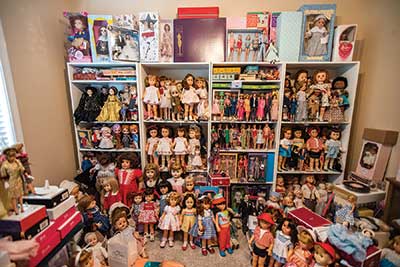
Moody collector amazes with her ‘finds’
Story by Leigh Pritchett
Photos by Kelsey Bain
Kathy Haynes’ house is full of babies … about a thousand of them actually.
She is not like the Old Woman Who Lived in a Shoe and “had so many children, she didn’t know what to do.” Quite the contrary, Mrs. Haynes knows exactly how to treat each one of hers. And there is always room for one more.
“I am one of those crazy doll ladies,” said Mrs. Haynes, who lives in Moody. “This is what I do. It is my hobby.”
Her collection of dolls encompasses more than 160 years. Every doll has a unique story, and Mrs. Haynes can easily recount the fine details of each.
One – an Effanbee Rosebud – spent much of its life in England, but somehow ended up in a Huffman antique shop where Mrs. Haynes bought her. She found some of her other dolls in thrift stores, garage sales, estate or doll sales and websites.
At a thrift store, she discovered a 1970s, red-haired Blythe doll that still worked and wore original clothes. “She was perfect, missing a shoe. I paid 59 cents for her and turned around that night and sold her for $1,000,” Mrs. Haynes said.
She found a Madame Alexander portrait doll in an Irondale thrift store. “I got her for $12.”
A 1950s Miss Revlon came from yet another thrift store. Miss Revlon cost Mrs. Haynes about $15. “Isn’t that unreal? But you have to know what you’re looking for,” Mrs. Haynes said.
The oldest of her brood is a flat-top, China-head doll Mrs. Haynes got for $15 at an antique store in Crestline. That treasure, dating to the 1860s, required a week of work to get all the cat hair off the dress.
The next oldest would be from the late 1800s, a Martha Chase doll and a papier mache doll with original clothes and, from around 1915, an Armand Marseille doll and two Kestner 171 dolls. The papier mache doll was a $10, thrift-store find.
Her collection fills several curios in her living room and dining room. Additionally, hundreds of dolls are on display in a designated room. A select few grace a guest room.
Her treasure trove also includes an Armand Marseille Queen Louise (circa 1915); Bye-Lo dolls with bisque or composite heads; Nancy Ann Storybook Dolls (1930s and ‘40s); Skookum Indian doll with papoose (1940s); Betsy McCall and large Mary Jane Effanbee dolls (1950s); Annalee soft-sculpture dolls; Barbies and more Barbies (1950s and across the decades); Little Miss Echo (1960s), and modern American Girl dolls, among others.
“I have a wide variety,” Mrs. Haynes said.
A love of teaching, history
For 30 years, Mrs. Haynes taught language and history to preteens in Trussville. She used an interactive method of teaching that, for example, encouraged students to “be” Egyptians for a day as they learned about the country. Mrs. Haynes would dress that day as Cleopatra.
Her whole family, in fact, is dedicated to conveying and preserving history. Husband Bob taught advance placement history to 10th and 11th graders in Trussville. Their son, Josh, has assumed that helm, along with coaching scholars’ bowl.
Mrs. Haynes cherishes things reminiscent of her childhood and items with a story, such as antique pieces handed down in the family. She collects cookie jars, Hummels, green and pink Depression Era glass, Byers Carolers, Raggedy Ann and Andy and stuffed bears. One of the bears was created by Trussville doll artist Jan Shackelford.
Even the family pets have their stories. Chance, for instance, is a rescue dog. Mrs. Haynes said her husband gave the dog that name because “we were giving him a chance, and he was giving us a chance.”
Because of her love for history, Mrs. Haynes said the intriguing background of Alabama Baby dolls would make them the dearest in her collection.

According to the Library of Congress and The American Folklife Center, Alabama Baby dolls were made in Roanoke, Ala., by Ella Gauntt Smith. In 1897, a neighborhood girl brought her broken bisque doll to Smith to repair. Smith was a seamstress, whose hymn-singing parrot would sit on her shoulder while she worked.
Smith experimented two years before finding the right method to repair the doll. From that, her doll-making business was born. In 1901, Smith received her first patent (albeit in her husband’s name). At the height of her business, about a dozen women worked with her, helping to create the plaster-headed dolls with fabric bodies. She was the first southern doll maker to produce Black dolls.
“These dolls are very special,” said Mrs. Haynes, who has four Alabama Baby dolls. One is a rare, barefoot Alabama Baby.
Though Alabama Baby dolls are Mrs. Haynes’ favorite, Chatty Cathy dolls would be a close second.
She has more than 100 Chatty Cathy dolls. She pulled the cord on one doll to demonstrate that its talk box still functions like new. “Tell me a story,” the doll proclaimed; with a subsequent pull, the doll asked, “Will you play with me?”
Smiling, Mrs. Haynes said, “I think she is a doll. Well, she is a doll!”
The different family groupings of Chatty Cathy dolls that Mrs. Haynes has assembled constitute a collection within a collection. She has Charmin’ Chatty, Chatty Baby, Tiny Chatty Baby, Chatty Brother and Singin’ Chatty dolls.
They feature varying styles and colors of hair, but almost all are wearing original outfits. Mrs. Haynes noted that Barbie and Chatty Cathy dolls shared the same fashion designer.
Holding a Black Tiny Chatty Baby doll, Mrs. Haynes remarked that very few of them were made. “Isn’t she cute?” Mrs. Haynes asked.
Mrs. Haynes also has rare Canadian Chatty Cathy dolls, which, unlike their American cousins, have glass eyes and pinker skin tones.
“I think I have about 10 Canadian ones in all,” she said.
When Mrs. Haynes was a child, her beloved Chatty Cathy doll was accidentally left in a park one day. She and her mother returned quickly to look for it, but the doll was gone.
Decades later, when Mrs. Haynes was in her 30s, her husband bought a blonde Chatty Cathy to replace the one she had lost.
“I just have a very sweet husband, … a blessing from the Lord, … a good Christian man,” Mrs. Haynes said.
Bob’s gift sparked 30 years of doll collecting, which has become an activity the couple enjoys together.
“He has always supported me,” Mrs. Haynes said. “… Bob just got into (doll collecting) with me. He went to doll shows with me. Now, he can tell you as much about Chatty Cathy as I can.”
Sharon Kirby of Vestavia Hills, who is president of The Birmingham Doll Club of Alabama, noted Mrs. Haynes’ extensive knowledge about Chatty Cathy dolls. She said Mrs. Haynes, who is first vice president, gave a presentation on Chatty Cathy to the club, which is the oldest United Federation of Doll Clubs (UDFC) group in the state. Kirby was so impressed with the presentation that she has encouraged Mrs. Haynes to give it at other UDFC groups.
“She just did a really wonderful job. … You could tell she was a teacher. … Everyone learned a lot,” Kirby said.
Kirby mentioned the interesting bit of trivia that Chatty Cathy and “Rocky” of the cartoon “Rocky and Bullwinkle” were voiced by the same person, June Foray.
Both Kirby and Mrs. Haynes said dolls not only offer a look into the past, but also preserve snippets of yesteryear.
“Dolls are a form of art,” Mrs. Haynes said. “They are also a part of our history.”
Kirby added, “Dolls kind of represent a snapshot of history at the moment – the fashion, the trends, I guess even the materials available.” They exemplify technology from their particular era, such as the mechanism that allowed Chatty Cathy to speak.
Through the generations, dolls have helped to teach children to use zippers and buttons, to nurture and “even to cut hair,” Kirby said, with a chuckle. “… If you like dolls, you see the beauty and value in them.”
Barbara Eiland of Trussville said she likes to see Mrs. Haynes’ “amazing” assortment of dolls. “They’re very interesting.”
Eiland, a long-time friend, described Mrs. Haynes as a caring person who diligently and lovingly attends to the needs of family, relatives, friends and neighbors. Mrs. Haynes is thoughtful, too, she said. After learning that Eiland, as a girl, loved Penny Brite dolls, Mrs. Haynes got her one.
“I thought that was so sweet of her to do that,” Eiland said. “… That meant a lot to me.” l
















